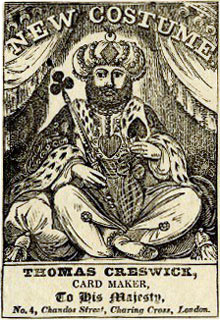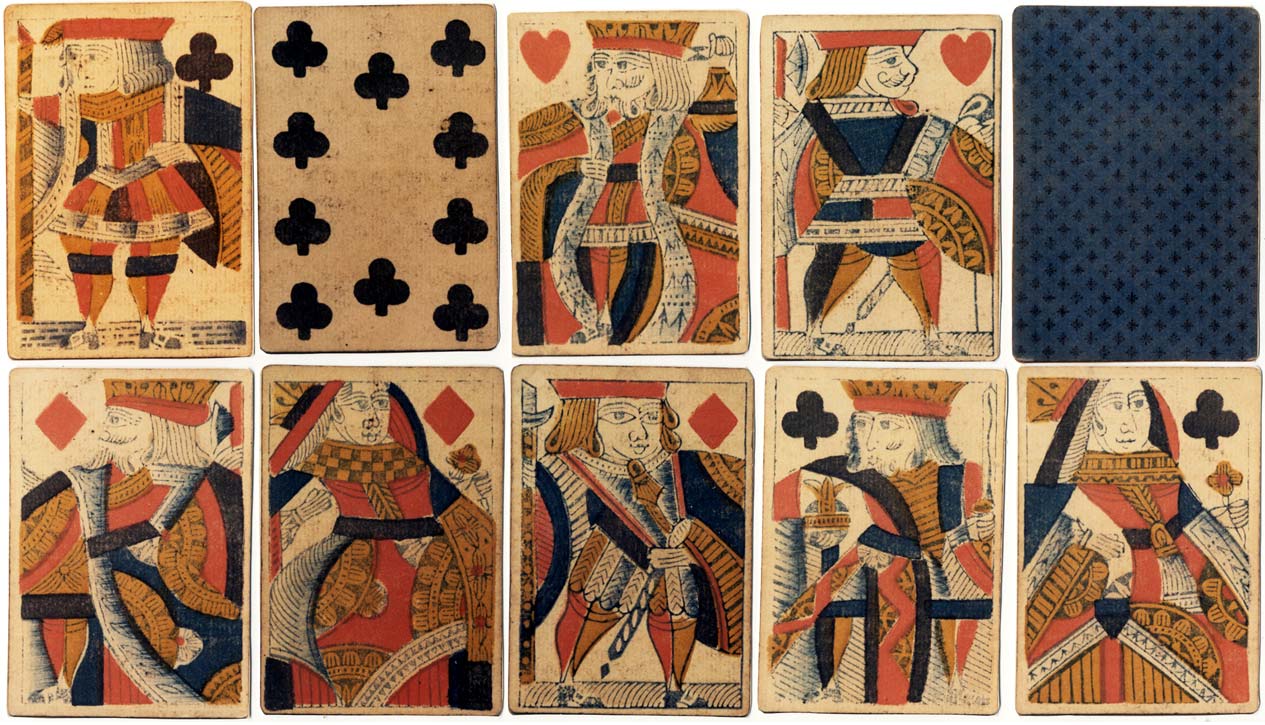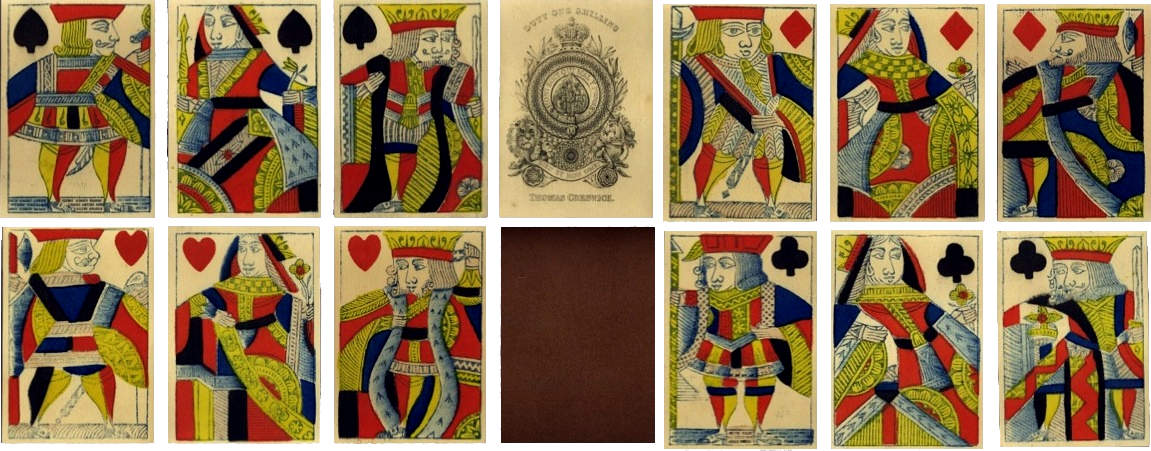Thomas Creswick
Thomas Creswick was a paper-maker and wholesale stationer. Playing cards were produced from c.1820 onwards.

Thomas Creswick, 16 Skinner Street, Snow Hill, London
Thomas Creswick was a paper-maker and wholesale stationer who first entered the card business in 1812. Standard woodblock & stencil playing cards were produced from c.1820 onwards, following the traditional designs, including smaller-sized piquet packs and a special non-standard pack featuring historical kings and queens of various nations in c.1830 (shown below). Advertisements of the day mentioned that Creswick took great pains to make cards which slip easily in the hand whilst also introducing improvements in the manufacturing process. Duty Aces of Spades were registered from c.1820, and an exportation Ace of Spades in 1828.
Creswick was appointed as manufacturer of paper and cards to William IV in 1831 and he advertised as such in 1834. Thomas Creswick died at 12 Clarendon Place, Maida Vale in September 1840, age 66, described as cardmaker and stationer of Chandos St (Gentleman's Magazine, 1840, vol.168, p.553).


Above: standard pack of English playing cards with 'Garter' Ace of Spades manufactured by Thomas Creswick, c.1825. The court cards in this example are of the type used by Josiah Stone. There seems to have been some kind of take-over c.1825, as there is reference in the taxation records to Creswick's taking over a number of Stone Garter ASs. More usually Creswick uses Type IV court cards (shown below).

Above: standard pack of English playing cards with 'Frizzle' Ace of Spades manufactured by Thomas Creswick, c.1830. This pack uses Creswick's more usual type of court card designs, except the red jacks which are of the Stone Type II kind. Image courtesy Ken Lodge.
King of Clubs. Pope wrote “That long behind he trails his pompous robes. And, of all the monarchs only grasps the globe”. The title “King of Clubs” was bestowed by Johnson on the Literary Club.
In his advertising sheet dating to about 1832, Creswick informed his customers that he had removed his ‘Warehouse and Manufactory’ to larger and more commodious premises at 4 Chandos St, ‘where he has now room enough for the sale of Paper of every variety, as well as the goods of his own Production’. As well as writing paper and playing cards, he offered various of his own papers, including ‘prepared smooth and rough surface’ white drawing papers, ‘tinted and coloured Drawing Papers, Originally invented by him with prepared Surface…’
Below: pack produced by Thomas Creswick in c.1830 with 'Old Frizzle' Ace of Spades depicting historical Kings and Queens of various nations. The Kings and Queens are unnamed but are evidently meant to represent actual people. The King of Clubs is Henry VIII.


Above: Imperial Playing cards prospectus on fly leaf of New Monthly Magazine, Dec. 1827. Source gallica.bnf.fr / Bibliothèque nationale de France • Imperial Playing Cards prospectus►
REFERENCES:
Lodge, Ken: The Standard English Pattern (second revised and enlarged edition), Bungay, Suffolk, 2010
For more about Creswick, see Ken Lodge's blog, pages 15 and 19: →

By Simon Wintle
Member since February 01, 1996
I am the founder of The World of Playing Cards (est. 1996), a website dedicated to the history, artistry and cultural significance of playing cards and tarot. Over the years I have researched various areas of the subject, acquired and traded collections and contributed as a committee member of the IPCS and graphics editor of The Playing-Card journal. Having lived in Chile, England, Wales, and now Spain, these experiences have shaped my work and passion for playing cards. Amongst my achievements is producing a limited-edition replica of a 17th-century English pack using woodblocks and stencils—a labour of love. Today, the World of Playing Cards is a global collaborative project, with my son Adam serving as the technical driving force behind its development. His innovative efforts have helped shape the site into the thriving hub it is today. You are warmly invited to become a contributor and share your enthusiasm.
Related Articles

Tangle Foot Ale
Badger Brewery Tangle Foot strong ale advertising pack.

Scientific Whist
“Scientific Whist” : standard cards with instructions for play on the faces by Chas Goodall & Son, 1...

Agent Provocateur
Branded lingerie collection in a pack of pin-up playing cards.

Nimbus playing cards
Mike Steer’s weather-themed pack with suits in four colours and backs for cardistry.

Agatha Christie and Playing Cards revisited
Agatha Christie uses card-play as a primary focus of a story, and as a way of creating plots and mot...

The Decadent Deck
Studies in the eroticism of the female body by Inge Clayton.

Historic Shakespeare
“Historic Shakespeare” playing cards featuring Shakespearean characters by Chas Goodall & Son.

Copechat Paramount Sorting System
Preserving the past: a specimen deck showcasing edge-notched cards and their ingenious sorting syste...

Heartsette by Herbert Fitch & Co, 1893
A glimpse into a busy print and design office in late Victorian London.

Batman® playing cards
Batman playing cards published by InterCol of London 1989.

Can You Believe Your Eyes?
“Can You Believe Your Eyes?” playing cards featuring visual illusions & other oddities.

Pastime Playing Cards for the Blind
The “Pastime” Playing Cards for the Blind manufactured by Goodall & Son Limd., c.1910.

Songs with Flute accompaniment
Eighteenth century English engraved cards with music for voice and flute.

Love Tests
Vintage novelty “Love Test” cards of a slightly saucy nature but all in good fun!

Ben 10 playing cards
Characters from the American animated television science fantasy series Ben 10.

Doctor Who Trump Card Game
Game for two players in which Doctor Who and the Legendary Legion join battle with the Alien Hordes....
Most Popular
Our top articles from the past 28 days

